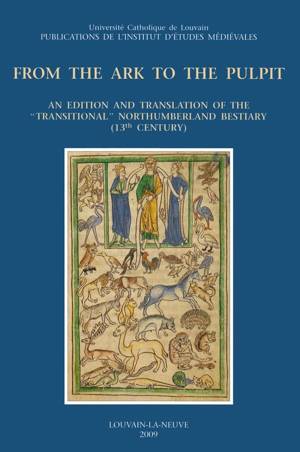
- Retrait en 2 heures
- Assortiment impressionnant
- Paiement sécurisé
- Toujours un magasin près de chez vous
- Retrait gratuit dans votre magasin Club
- 7.000.0000 titres dans notre catalogue
- Payer en toute sécurité
- Toujours un magasin près de chez vous
From the Ark to the Pulpit
An Edition and Translation of the Transitional Northumberland Bestiary (13th Century)
C. White
Livre broché | Anglais
58,30 €
+ 116 points
Description
This publication of the thirteenth-century Northumberland Bestiary, formerly the Alnwick Bestiary, provides a complete critical edition of one of the most developed Medieval Latin bestiaries. Even among the few manuscripts in its group, called the transitional family of bestiaries, the Northumberland Bestiary is unique: it crystallizes the fluid combination of narrative, animal lore, and spiritual guidance that characterize the genre. Beginning with creation and covering the gamut of real and imaginary beasts, birds, fish, serpents, worms, man, and trees, this bestiary is a spiritual journey as well as a scientific manual. Under the pretense of zoology, the bestiary is a metaphor for divine creation, a message from the creator through creation. Medieval preachers used the pretense as well as the spiritual allegories that accompany the creatures to instruct their congregations. The Northumberland Bestiary was the last known bestiary in private hands until 2007 when the J. Paul Getty Museum acquired it. Written about 1250, in a small, early gothic book hand, it is one of the richest of all Latin bestiary manuscripts produced in England. There are 112 finely drawn and colored miniatures among its 74 leaves as well as an elegant and discrete Sermon on How a Sinner May Be Pleasing to God (Sermo qualiter peccator Deo placere valeat), which was likely directed to clerics who were training to work as pastors. For a general as well as a scholarly readership, this edition captures the charming essence of the bestiary tradition in a readable Latin-English format.The book comprises a general introduction discussing the text and the manuscript, the Latin text with English translation, notes and commentary, a description of all the miniatures, and reproductions of about thirty of them.
Spécifications
Parties prenantes
- Auteur(s) :
- Editeur:
Contenu
- Nombre de pages :
- 436
- Langue:
- Anglais
Caractéristiques
- EAN:
- 9782960076929
- Date de parution :
- 26-02-10
- Format:
- Livre broché
- Format numérique:
- Trade paperback (VS)
- Dimensions :
- 160 mm x 240 mm
- Poids :
- 820 g

Seulement chez Librairie Club
+ 116 points sur votre carte client de Librairie Club
Les avis
Nous publions uniquement les avis qui respectent les conditions requises. Consultez nos conditions pour les avis.








